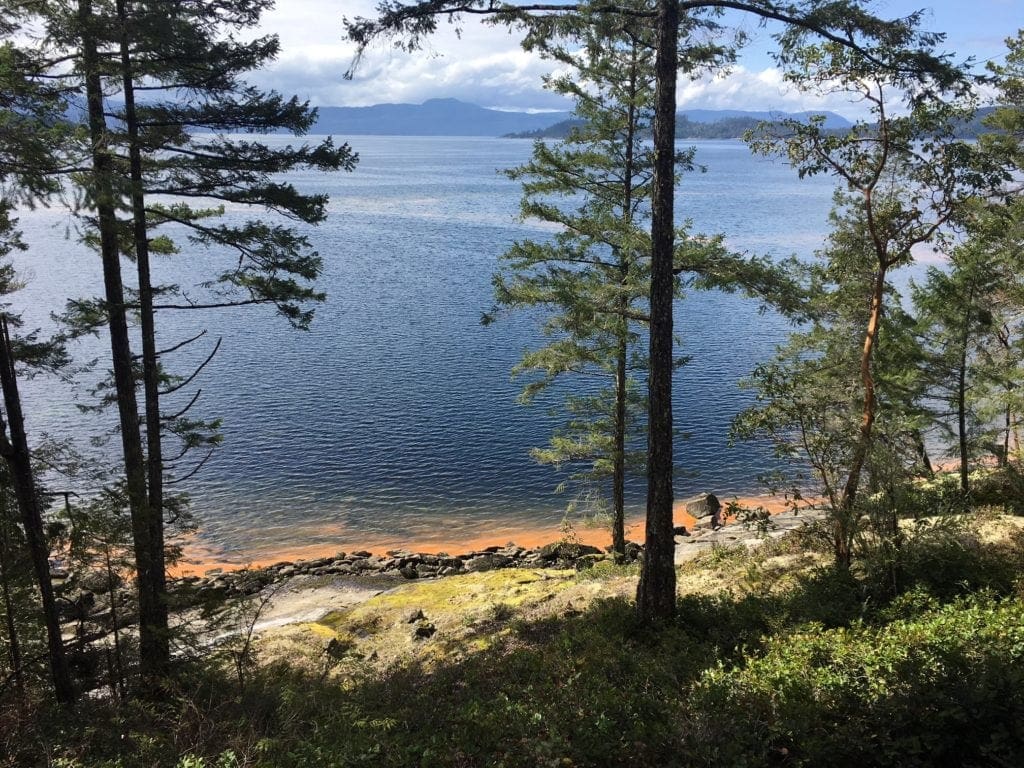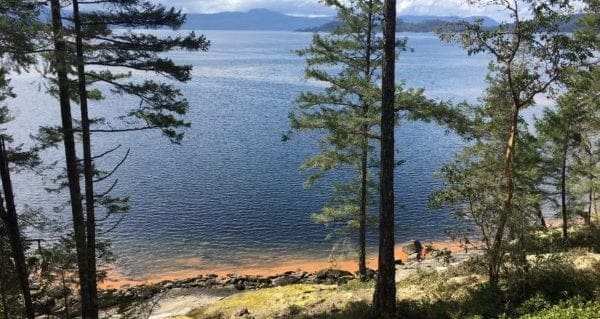
Red tide along our shoreline at Skelhp. Plenty of suggestions about the source but no definitive answer. Photo by Mike Robinson
 I recently made the trip up the Sunshine Coast from Vancouver to Skelhp under sunny skies with spring projects in mind.
I recently made the trip up the Sunshine Coast from Vancouver to Skelhp under sunny skies with spring projects in mind.
It’s still a month before the vegetable garden needs to be seeded, but it’s time to rake in some fireplace ash and turn the soil in the rows. The raspberry canes need pruning, and the dahlia bulbs need to be removed from their overwintering box in the garage and dug into their beds.
Hopefully we didn’t over-prune the Bing cherry trees and the yellow delicious apple trees in the orchard last month. Both should soon start to blossom.
It’s also the time of year for spring surprises.
After parking the pickup truck close to the house to unload groceries, I went down to the beach. Ye gods – there was a salmon-pink band of colour all along the waterfront. It seemed to be some sort of dense algae, lapping at the beach rock and extending maybe 10 metres offshore. And out in the centre of the inlet, there were several other broad bands of the same colour, extending hundreds of metres east and west on the calm waters.
My brain immediately registered that I had seen this colour coating the coastline once before, perhaps five years ago. At the time and now I thought, “It must be red tide.”
Red tide is an old local term for a phenomenon caused by a few species of dinoflagellates (aquatic microorganisms) growing out of control, often fed by high levels of fecal coliform. Various government websites call red tide paralytic shellfish poison (PSP) and warn that it causes bivalve molluscs (shellfish with two shells) contamination that’s hazardous to human health, in some cases leading to potentially fatal illnesses like PSP.
I photographed the bloom on our waterfront and posted it on Facebook, asking for observations. Over the following 24 hours, several old coastal hands weighed in with various comments: “No clams or oysters for you this year;” “The water is still too cold for red tide – it must be something else;” “You’ve got salmon farms in open net pens nearby and a pulp mill up the coast. Has there been some kind of spill?”
I went down to the BC Ferry wharf and asked the deck hands if they had heard anything conclusive? One reported overhearing, “a heated argument about what it was – but it was inconclusive.”
A week later there were no warning signs posted by any government agency, so I sent my photographs to a Department of Fisheries and Oceans (DFO) representative in Nanaimo. So far I have no response.
Last night we went for dinner with a party of longtime local residents, two of whom have had coastal flying careers in sea planes. They listened to my red tide report and quickly suggested that what we were dealing with was Douglas fir pollen.
‘Doug’ firs are thick on the coastal hillsides surrounding Skelhp and apparently their yellow, airborne pollen turns red in tidewater.
Of all the reports so far, this one seemed to have the most authenticity. So I’m about 75 per cent convinced it’s not red tide. But not beyond a reasonable doubt. Until I resolve my doubt, there will be no clam chowders or oyster feasts at Skelhp.
I was thinking the red tide dilemma over on a walk up our gravel road to the highway when I saw what appeared to be two black legs sticking out beyond a raised flower box by the gate. I stopped and watched as they bent and a black humped back arose from what must have been a nap on the grass. Last of all, an enormous black bear head lifted and turned in my direction. The bear was a bit groggy, easily over 90 kg (200 pounds) and maybe 100 metres away.
“The first bear of the season, I wonder if it’s Cuddles?” I thought, remembering my daughter’s bear cub nickname of a few years ago.
The big bear was not skinny. When finally erect on four legs, it wandered very slowly into the adjacent bush.
“Red tide and Cuddles,” I thought. Spring is now definitely with us.
Just then I realized I was without my trusty can of bear spray, so I turned and began walking rather quickly down the road to our house.
Troy Media columnist Mike Robinson has been CEO of three Canadian NGOs: the Arctic Institute of North America, the Glenbow Museum and the Bill Reid Gallery.
The views, opinions and positions expressed by columnists and contributors are the author’s alone. They do not inherently or expressly reflect the views, opinions and/or positions of our publication.

